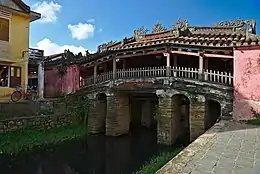Hội An
Hội An (Vietnamese: [hôjˀ aːn] (![]() listen)), formerly known as Fai-Fo or Faifoo, is a city with a population of approximately 120,000 in Vietnam's Quảng Nam Province and noted since 1999 as a UNESCO World Heritage Site.
listen)), formerly known as Fai-Fo or Faifoo, is a city with a population of approximately 120,000 in Vietnam's Quảng Nam Province and noted since 1999 as a UNESCO World Heritage Site.
Hội An
Thành Phố Hội An | |
|---|---|
| Hội An City | |
.jpg.webp) A view of the old town - UNESCO World Heritage Site | |
 Seal | |
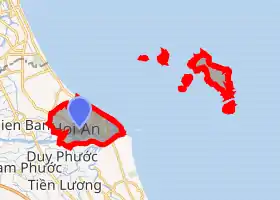
Interactive map outlining Hội An | |
 Hội An Location of Hội An in Vietnam | |
| Coordinates: 15°53′N 108°20′E | |
| Country | |
| Province | Quảng Nam Province |
| Area | |
| • Total | 60 km2 (20 sq mi) |
| Population (2018) | |
| • Total | 152,160 |
| • Density | 2,500/km2 (6,600/sq mi) |
| Climate | Am |
| Official name | Hoi An Ancient Town |
| Criteria | Cultural: (ii), (v) |
| Reference | 948 |
| Inscription | 1999 (23rd session) |
| Area | 30 ha (74 acres) |
| Buffer zone | 280 ha (690 acres) |
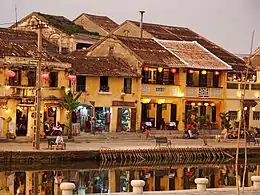
Old Town Hội An, the city's historic district, is recognized as an exceptionally well-preserved example of a Southeast Asian trading port dating from the 15th to the 19th century, its buildings and street plan reflecting a blend of indigenous and foreign influences.[1][2] Prominent in the city's old town, is its covered "Japanese Bridge", dating to the 16th-17th century.
Etymology
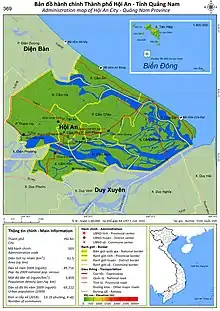
Hội An (會安) translates as "peaceful meeting place". In English and other European languages, the town was known historically as Faifo. This word is derived from Vietnamese Hội An phố (the town of Hội An), which was shortened to "Hoi-pho", and then to "Faifo".[3]
History
Cham period (Century II-XV)
Between the seventh and 10th centuries, the Cham (people of Champa) controlled the strategic spice trade and with this came tremendous wealth.
The early history of Hội An is that of the Cham. These Austronesian-speaking Malayo-Polynesian peoples created the Champa Empire which occupied much of what is now central and lower Vietnam, from Huế to beyond Nha Trang. Various linguistic connections between Cham and the related Jarai language and the Austronesian languages of Indonesia (particularly Acehnese), Malaysia, and Hainan has been documented. In the early years, Mỹ Sơn was the spiritual capital, Trà Kiệu was the political capital and Hội An was the commercial capital of the Champa Empire - later, by the 14th century, the Cham moved further down towards Nha Trang. The river system was used for the transport of goods between the highlands, inland countries of Laos and Thailand and the low lands.
Vietnamese period
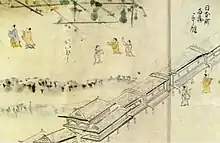
In 1306, Vietnamese and Cham signed a land treaty, which Cham king Jaya Simhavarman III gave Dai Viet two provinces of Ô and Lý to exchange a long-term peace and marriage with king Trần Nhân Tông's daughter Huyền Trân.[4]:86–87,205 In 1471 Emperor Lê Thánh Tông of Đại Việt annexed Champa[5] and Hội An became a Vietnamese urban, also the capital of province Quảng Nam.[6]:23 In 1535 Portuguese explorer and sea captain António de Faria, coming from Da Nang, tried to establish a major trading centre at the port village of Faifo.[7] Since 1570, Southern Vietnam had been under control of powerful Nguyễn clan, established by governor Nguyễn Hoàng. The Nguyễn lords were far more interested in commercial activity than the Trịnh lords who ruled the north. As a result, Hội An flourished as a trading port and became the most important trade port on the South China sea. Captain William Adams, the English sailor and confidant of Tokugawa Ieyasu, is known to have made one trading mission to Hội An in 1617 on a Red Seal Ship.[8] The early Portuguese Jesuits also had one of their two residences at Hội An.[9]
Hội An was a divided town with the Japanese settlement across the "Japanese Bridge" (16th-17th century).The bridge (Chùa cầu) is a unique covered structure built by the Japanese merchants, the only known covered bridge with a Buddhist temple attached to one side. In the 18th century, Hội An was considered by Chinese and Japanese merchants to be the best destination for trading in all of Southeast Asia, even Asia. The city also rose to prominence as a powerful and exclusive trade conduit between Europe, China, India, and Japan, especially for the ceramic industry. Shipwreck discoveries have shown that Vietnamese and Asian ceramics were transported from Hội An to as far as Sinai, Egypt.[10]

Hội An's importance waned sharply at the end of the 18th century because of the collapse of Nguyễn rule (thanks to the Tây Sơn Rebellion - which was opposed to foreign trade). In 1775, Hội An had been the battleground between Trịnh army and Tây Sơn rebels, and the city was destroyed.[6]:28 Then, with the triumph of Emperor Gia Long, he repaid the French for their aid by giving them exclusive trade rights to the nearby port town of Đà Nẵng. Đà Nẵng became the new centre of trade (and later French influence) in central Vietnam while Hội An was a forgotten backwater. Local historians also say that Hội An lost its status as a desirable trade port due to silting up of the river mouth. The result was that Hội An remained almost untouched by the changes to Vietnam over the next 200 years. The efforts to revive the city were only done by a late Polish architect and influential cultural educator, Kazimierz Kwiatkowski, who finally brought back Hội An to the world. There is still a statue for the late Polish architect in the city, and remains a symbol of the relationship between Poland and Vietnam, which share many historical commons despite its distance.[11]
Today, the town is a tourist attraction because of its history, traditional architecture and crafts such as textiles and ceramics. Many bars, hotels, and resorts have been constructed both in Hội An and the surrounding area. The port mouth and boats are still used for both fishing and tourism.
Weather
Hoi An has two main seasons during the year: rainy and dry seasons, with a warm average temperature of 29 °C during the year. The hottest period is from June to August when the highest temperature can reach 38 °C during day time. November to January will be the coldest months with an average temperature of 20 °C. The rainy season lasts from September to January with heavy rains which can cause floods and affect tourism. The city's dry season is between February and May when the weather becomes very mild with moderate temperature and less humid.[12] Calm mild weather is now limited to the season of May/June - end of August when the seas are calm and wind changes direction and comes from the South. The remainder of the year the weather is intermittent between rain & cold and hot & mild. Activities such as visiting offshore Cù lao Chàm islands are only guaranteed to be likely during the short season of end of May to end of August, which is the high season for domestic tourism.
Heritage and tourism
In 1999 the old town was declared a World Heritage Site by UNESCO as a well-preserved example of a Southeast Asian trading port of the 15th to 19th centuries, with buildings that display a blend of local and foreign influences. According to the UNESCO Impact Report 2008 on Hội An, tourism has brought changes to the area which are not sustainable without mitigation.
Owing to the increased number of tourists visiting Hoi An a variety of activities are emerging that allow guests to get out of the old quarter and explore by motorbike, bicycle, kayak, or motorboat. The Thu Bon River is still essential to the region more than 500 years after António de Faria first navigated it and it remains an essential form of food production and transport. As such kayak and motorboat rides are becoming an increasingly common tourist activity.[13]
This longtime trading port city offers a distinctive regional cuisine that blends centuries of cultural influences from East and Southeast Asia. Hoi An hosts a number of cooking classes where tourists can learn to make cao lầu or braised spiced pork noodle, a signature dish of the city.[14]
The Hoi An wreck, a shipwreck from the mid- to late-fifteenth century, was discovered off the coast of the city in the 1990s. A few years later, it was excavated; thousands of ceramic artefacts were discovered.
Another attraction is the Hoi An Lantern Full Moon Festival[15] taking place every full moon cycle. The celebrations honour the ancestors. People exchange flowers, lanterns, candles, and fruits for prosperity and good fortune.[16]
The Faifo Coffee house has an open air rooftop that has become a particularly popular location for Asian tourists to stop for well dressed selfies and posed photos.[17]
Museums
The city has four museums highlighting the history of the region. These museums are managed by the Hoi An Center for Cultural Heritage Management and Preservation. Entrance to the museum is permitted with a Hoi An Entrance Ticket.[18]
The Museum of History and Culture, at 13 Nguyen Hue St, was originally a pagoda, built in the 17th century by Minh Huong villagers to worship the Guanyin, and is adjacent to the Guan Yu temple. It contains original relics from the Sa Huynh, Champa, Dai Viet and Dai Nam periods, tracing the history of Hoi An's inhabitants from its earliest settlers through to French colonial times.[19]
The Hoi An Folklore Museum, at 33 Nguyen Thai Hoc Street, was opened in 2005, and is the largest two-storey wooden building in the old town, at 57m long and 9m wide, with fronts at Nguyen Thai Hoc St and Bach Dang St. On the second floor, there are 490 artifacts, organised into four areas: plastic folk arts, performing folk arts, traditional occupations and artifacts related to the daily life of Hoi An residents.[20]
The Museum of Trade Ceramics is located at 80 Tran Phu Street, and was established in 1995, in a restored wooden building, originally built around 1858. The items originating from Persia, China, Thailand, India and other countries are proof of the importance of Hội An as a major trading port in South East Asia.[21]
The Museum of Sa Huỳnh Culture, is located at 149 Tran Phu Street. Established in 1994, this museum displays a collection of over 200 artifacts from the Sa Huỳnh culture—considered to be the original settlers on the Hội An site—dating to over 2000 years ago. This museum is considered to be the most unusual collection of Sa Huỳnh artefacts in Vietnam.[22]
The Precious Heritage Museum is located at 26 Phan Boi Chau. It includes a 250m2 display of photos and artifacts collected by Réhahn during the past 5 years of the French photographer's explorations of Vietnam. [23]
Food
According to CNN, Hoi An is the "banh mi capital of Vietnam."[24] Banh Mi is a type of Vietnamese sandwich, consisting of a French baguette, pâté, meats and fresh herbs. It is a fusion of French and Vietnamese cuisine.[25]
The regional dish is Cao lầu, consisting of rice noodles, meat, greens, bean sprouts, and herbs, most commonly served with a small amount of broth. The water for the broth has been traditionally taken from the Ba Le Well, thought to have been built in the 10th century by the Chams.
Other regional specialties include mi quang noodles, banh bao banh vac, hoanh thanh, com ga (chicken with rice), bánh xèo, sweet corn soup and baby clam salad are also regional specialties.[26]
Gallery
 Streets of Hội An Ancient Town
Streets of Hội An Ancient Town Streets of Hội An Ancient Town
Streets of Hội An Ancient Town Streets of Hội An Ancient Town
Streets of Hội An Ancient Town._Hoi_An_Ancient_Town_pagodas.jpg.webp) Dragon fountain at the back of the Cantonese Assembly Hall (Quảng Triệu). Hội An Ancient Town pagodas
Dragon fountain at the back of the Cantonese Assembly Hall (Quảng Triệu). Hội An Ancient Town pagodas.jpg.webp) Beach of Hoi An
Beach of Hoi An.jpg.webp) Hoi An lanterns
Hoi An lanterns.jpg.webp) Wooden House in Hanoi, Vietnam
Wooden House in Hanoi, Vietnam.jpg.webp) Hoi An Lampions
Hoi An Lampions.jpg.webp) Bridge in Hoi An, Vietnam
Bridge in Hoi An, Vietnam Hội An Ancient Town
Hội An Ancient Town Typical shop of Hội An
Typical shop of Hội An Riverfront
Riverfront Sino-Portuguese architecture style building in Hội An's old quarter
Sino-Portuguese architecture style building in Hội An's old quarter Hội An's handcrafted lanterns
Hội An's handcrafted lanterns Nightlife in the Hội An old town district, in 2013.
Nightlife in the Hội An old town district, in 2013. Fishermen near Hoi An
Fishermen near Hoi An Japanese Covered Bridge in Hội An
Japanese Covered Bridge in Hội An Woman wearing Ao Dai in Hội An
Woman wearing Ao Dai in Hội An Hawker in Hội An
Hawker in Hội An bridge in Hội An
bridge in Hội An.jpg.webp) Fukian Assembly Hall (Hoi An)
Fukian Assembly Hall (Hoi An)
See also
References
- https://whc.unesco.org/en/list/948
- Laurent Bourdeau (dir.) et Sonia Chassé - Actes du colloque sites du patrimoine et tourisme - Page 452 "In Việt Nam, for example, the imperial capital of Huế, the sanctuary of the minority Cham people of Mỹ Sơn, and the "ancient town" of Hội An have all been designated through years of politicking between local leaders (who often solicit help ..
- Chen, Chingho. Historical Notes on Hội-An (Faifo). Carbondale, Illinois: Center for Vietnamese Studies, Southern Illinois University at Carbondale, 1974. p 10.
- Maspero, G., 2002, The Champa Kingdom, Bangkok: White Lotus Co., Ltd., ISBN 9747534991
- https://books.google.com/books?id=Jskyi00bspcC
- Fukukawa Yuichi, Kiến trúc phố cổ Hội An - Việt Nam, Chiba University, 2006
- Spencer Tucker, "Vietnam", University Press of Kentucky, 1999, ISBN 0-8131-0966-3, p. 22
- Roland Jacques Portuguese pioneers of Vietnamese linguistics prior to 1650 2002 Page 28 "At the time Pina wrote, early 1623, the Jesuits had two main residences, one in Hội An in Quảng Nam, the other at Quy Nhơn."
- Li Tana (1998). Nguyen Cochinchina p. 69.
- https://culture.pl/en/artist/kazimierz-kwiatkowski
- "Hoi An weather, best time to visit Hoi An Vietnam". www.vietnamonline.com. Retrieved 7 January 2019.
- Hoiankayak.com
- "Traveling, Eating, and Cooking in Hoi An, Vietnam - Bon Appétit". Retrieved 2016-08-13.
- "Hoi An Lantern Full Moon Festival".
- "Festivals in Hoi An".
- https://www.rustycompass.com/vietnam-travel-guide-233/hoi-an-28/eating-16/faifo-coffee-hoi-an-1460#.XglFmsAxXDs
- "Entrance Ticket in Hoi An Ancient Town". The Centre for Culture and Sports of Hoi An city. Retrieved 20 November 2013.
- "Museum of History and Culture". The Centre for Culture and Sports of Hoi An city. Retrieved 20 November 2013.
- "Hoi An Museum of Folk Culture". The Centre for Culture and Sports of Hoi An city. Retrieved 20 November 2013.
- "Museum of Trade Ceramics". The Centre for Culture and Sports of Hoi An city. Retrieved 20 November 2013.
- "Sa Huynh Culture Museum". The Centre for Culture and Sports of Hoi An city. Retrieved 20 November 2013.
- "Precious Heritage Museum". Réhahn Photography. Retrieved 20 November 2013.
- Springer, Kate (June 17, 2019), 7 reasons to visit Hoi An, one of Vietnam's most beautiful towns, CNN, retrieved January 19, 2020
- Be, Nina. "Banh Mi Phuong – Hoi An's Best Banh Mi". Hidden Hoi An. Retrieved 4 May 2020.
- Avieli, Nir. Rice Talks: Food & Community in a Vietnamese Town.
External links
| Wikivoyage has a travel guide for Hội An. |
- Hoi An Ancient Town from UNESCO
- Hoi An World Heritage - Government website with tourist information.
 Media related to Hoi An at Wikimedia Commons
Media related to Hoi An at Wikimedia Commons Geographic data related to Hội An at OpenStreetMap
Geographic data related to Hội An at OpenStreetMap
